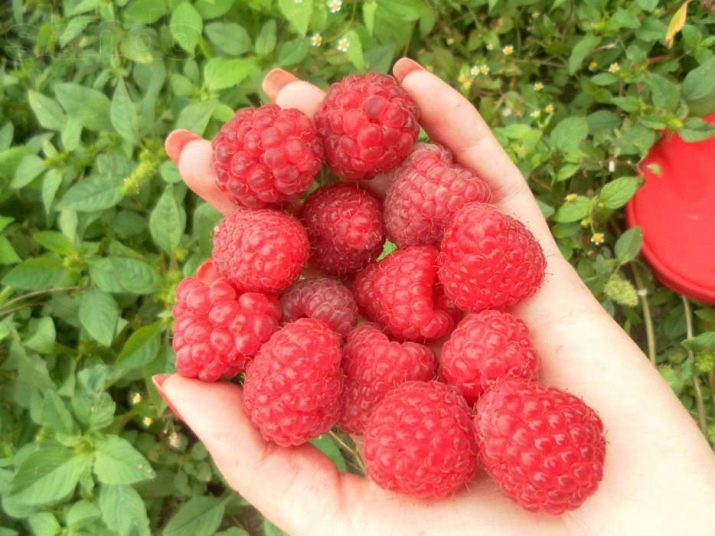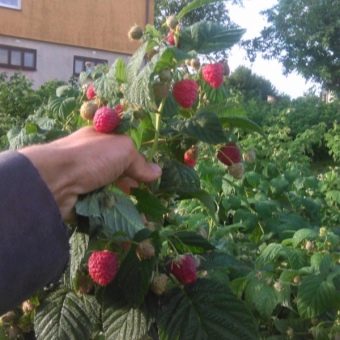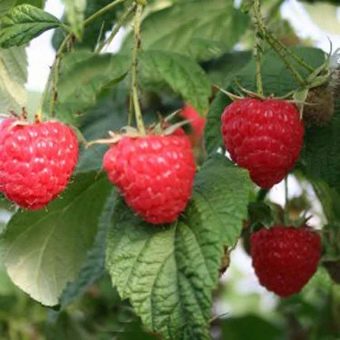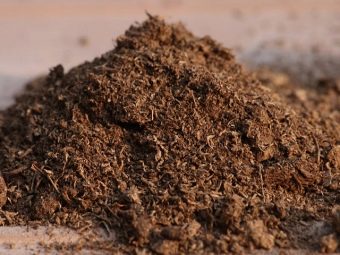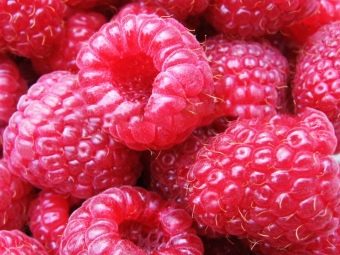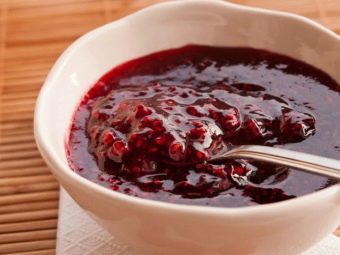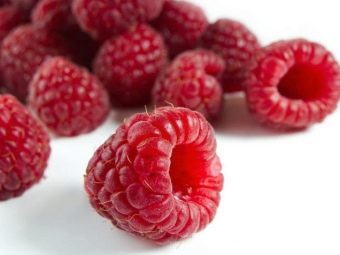Raspberry Sugana: rules for planting and care
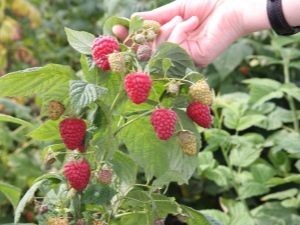
One of the most important criteria when choosing fruit varieties for a home plot is the yield and size of the fruit. Malina Sugana was bred in Switzerland and already in 1999firmly established in the cottages and gardens. Currently, every gardener, if not engaged in its independent cultivation, then at least heard about this raspberry variety.
Characteristic features of raspberry variety Sugana
Shoots of this variety often reach 2 meters in height, without losing their strength. As a rule, tall raspberry shoots need additional garter, which is not necessary for Sugana raspberries. Despite this, the use of trellis allows you to keep the bush in a more stable position, protects from damage by wind loads and gives the site a well-groomed appearance.
At the same time, various types of diseases and pests have little effect on the repair stability of Sugana raspberries, which makes it possible to guarantee more than one crop of berries from their plot. The diameter of the bush can be 0.7 meters, spikes on the shoots are missing, which allows to significantly reduce the number of scratches during the collection of berries.
On the main shoot there is a large number of fruit-bearing shoots capable of producing more than one crop. The leaves of the shrub are of dark green color and about 10 cm in size. This raspberry variety is able to bear fruit twice a year.
However, it should be borne in mind that for guaranteed fruiting twice a day, plant care must be timely, correct and qualified.
Regarding frost resistance, the official description of Sugana raspberry coincides with the reviews of gardeners: the variety tolerates significant temperature drops. According to independent experts, frost resistance in this class is 9 points out of 10 possible, which makes it possible to grow crops in almost all climatic zones.
With regard to yield, according to reviews of some gardeners, from one bush of raspberry Sugana can be collected in one season up to 9.5 kg. This yield is truly unique, while the taste of the berries and their flavor exceed all expectations. Another advantage of this raspberry variety is that the shape of the berries is almost identical.
You can harvest for a long time, the fruits are tightly held on the branches and fall off a little. The advantages of this variety include the possibility of relatively safe transportation and long-term storage without losing the shape, flavor and taste. Without any additional conditions, the berries will not spoil even in 3 days, and when chilled, a week or more.
How to start landing?
Like any other plant, raspberry sugana needs proper care, which begins with the planting of seedlings. Having made even the smallest omission at this stage, it is difficult to count on the fact that the bush will take root well in the future. If the landing site is selected, make sure that:
- the site should be well lit;
- try to keep it as close as possible to the north;
- Sugana raspberries should not be planted in the lowlands and on the slopes;
- the ground should be loose, soft and fertile.
As a trellis, you can use an ordinary fence that will protect young shoots from sudden gusts of wind and scrapping. You should not be upset if you did not manage to fertilize the soil in advance; Sugana raspberry can be grown on soils with medium fertility.
If the soil is acidic, you need to dig up the landing site with the addition of wood ash, and you can spend liming.
Starting the landing process, do not forget the basic rules:
- the bottom of each well must be fertilized with a mineral or organic complex;
- plant raspberries need to wet the mail;
- planting is carried out in such a way that the distance between the seedlings is not less than 0.5 m, and the width between the rows is 1.5-3 m;
- optimal planting time for seedlings is either early spring or mid-autumn;
- The soil mulch after planting not only protects seedlings from frost, but also serves as an additional top dressing, and the mulch layer should be in the range of 5 to 10 cm.
Proper care of raspberries
To ensure maximum yield when caring for Sugana raspberries, the following activities should be carried out in a timely manner:
- regular watering;
- tillage with mulch;
- systematic feeding;
- pruning of obsolete shoots;
- loosening the soil.
For the formation and development of any fruit, a sufficient amount of moisture is necessary, so watering is one of the most important elements of care. Raspberry Sugana has shallow roots, therefore cannot feed on groundwater. It is for this reason that when the soil dries around the bush, it must be watered quickly. The use of mulch reduces evaporation and allows longer retain moisture in the ground, so wood chips, peat, hay, straw can be good helpers to any gardener and gardener.
Significantly increase not only the quantity, but also the size of the berries will help properly chosen dressing. In addition, timely fertilizers help the bush to avoid various diseases.
Depending on the time of year there are optimal options for feeding. This is due to the fact that in the spring-summer period it is necessary to ensure the intensive growth of the shrub, while in the cold season there is no such need.
In the period of spring and summer, it is advisable to use urea or saltpeter. Such fertilizers contain potassium, phosphorus and calcium, allowing the plant to actively develop. When a period of intensive growth is left behind, special mineralized complexes can be applied, taking into account the peculiarities of the soil. Dead manure can replace this mineral composition to some extent. Regardless of the type of fertilizer, fertilizing should be carried out in dry weather, if possible, in moist soil. It is not advisable to top dressing before watering or rain, because fertilizers can be washed away from the ground surface with water streams.
In the fall and during the first cold season, many gardeners use superphosphate. The presence of oxygen in the soil affects the rate of chemical reactions, and, consequently, the growth rate, so timely loosening of the soil is also of great importance. It should not be forgotten that the Sugana raspberry root system is located quite close to the ground surface, and it is easy to damage it with garden tools.
Loosening is necessary at a sufficient distance from the bush with a special garden tool.
In addition, the yield of the outdated branches carried out in time greatly influences the yield of Sugana raspberries. Based on the feedback from gardeners, the optimum time for pruning the Sugana raspberry bushes is mid-autumn, when the harvest is complete and the bush ceases to bear fruit. The technological feature of pruning is the removal of all damaged and obsolete branches; you should leave no more than 7-8 fresh processes, which will bear fruit next year.
Re-pruning is carried out in early spring, while removing all new shoots, leaving no more than 10 shoots. For the Sugana raspberry garter, spring is also the most suitable season, since with proper care, the main shoots should be 0.8–1 m in height, after which you can start cupping, stimulating the growth process. Cupping is called pruning of the tips of the shoots, leading to their more intensive development.
Benefits
Hardly anyone left indifferent photos of these large fragrant berries. The ability to double harvest, taste and aromatic qualities of raspberry Sugana, as well as its resistance to frost, diseases of shoots and the root system make it one of the most popular raspberry varieties. In addition, the berries have a wide range of healing properties and are useful in the treatment of many respiratory and more serious diseases.
Having landed Sugana raspberries on the plot, you will provide yourself not only with delicious desserts, but also with medical jams and preserves.
Reviews
Responses gardeners and gardeners mostly positive.For example, some users say that Sugana raspberry seedlings were bought to grow berries for their own needs. However, in the second season, it became clear that the yield of this variety can feed not only a specific family, but also provide a good income.
It is noted that the care of shrubs did not require any extraordinary efforts, the variety is quite unpretentious and tolerates frost well.
Particularly satisfied are those who have very little time to care for the shrubs, so they were pleasantly surprised by the number of berries. Everyone likes the size of the berries, the taste and their aroma. In addition, raspberry bushes of this variety are unpretentious and do not require large labor costs.
Some gardeners point out the possibility of planting a variety even in a small area, and the harvest, as a rule, exceeds all expectations.
It is often expensive for the family budget to buy raspberries in the market, therefore landowners of the garden planted Sugana raspberries, as the neighbors advised. Even after surviving the cold winter, the seedlings do not die, and in the summer they produce crops that are enough for the whole family.
But there are negative reviews. It is noted that in the wet climate raspberry does not survive, begins to rot and dies. In addition, in the rainy season, the berries are watery and less sweet.
As a rule, the harvest is rather late. If an early autumn suddenly comes, the berries do not have time to ripen. In this case, experienced gardeners are advised to cover the raspberries with agrofiber.

